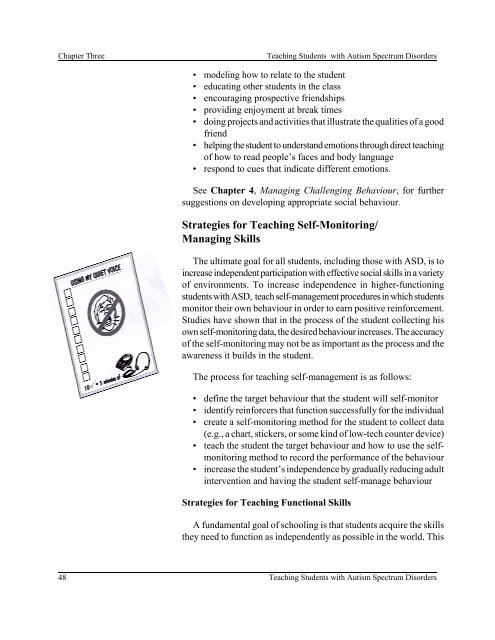Teaching Students with Autism Spectrum Disorders
Teaching Students with Autism Spectrum Disorders
Teaching Students with Autism Spectrum Disorders
You also want an ePaper? Increase the reach of your titles
YUMPU automatically turns print PDFs into web optimized ePapers that Google loves.
Chapter Three <strong>Teaching</strong> <strong>Students</strong> <strong>with</strong> <strong>Autism</strong> <strong>Spectrum</strong> <strong>Disorders</strong><br />
• modeling how to relate to the student<br />
• educating other students in the class<br />
• encouraging prospective friendships<br />
• providing enjoyment at break times<br />
• doing projects and activities that illustrate the qualities of a good<br />
friend<br />
• helping the student to understand emotions through direct teaching<br />
of how to read people’s faces and body language<br />
• respond to cues that indicate different emotions.<br />
See Chapter 4, Managing Challenging Behaviour, for further<br />
suggestions on developing appropriate social behaviour.<br />
Strategies for <strong>Teaching</strong> Self-Monitoring/<br />
Managing Skills<br />
The ultimate goal for all students, including those <strong>with</strong> ASD, is to<br />
increase independent participation <strong>with</strong> effective social skills in a variety<br />
of environments. To increase independence in higher-functioning<br />
students <strong>with</strong> ASD, teach self-management procedures in which students<br />
monitor their own behaviour in order to earn positive reinforcement.<br />
Studies have shown that in the process of the student collecting his<br />
own self-monitoring data, the desired behaviour increases. The accuracy<br />
of the self-monitoring may not be as important as the process and the<br />
awareness it builds in the student.<br />
The process for teaching self-management is as follows:<br />
• define the target behaviour that the student will self-monitor<br />
• identify reinforcers that function successfully for the individual<br />
• create a self-monitoring method for the student to collect data<br />
(e.g., a chart, stickers, or some kind of low-tech counter device)<br />
• teach the student the target behaviour and how to use the selfmonitoring<br />
method to record the performance of the behaviour<br />
• increase the student’s independence by gradually reducing adult<br />
intervention and having the student self-manage behaviour<br />
Strategies for <strong>Teaching</strong> Functional Skills<br />
A fundamental goal of schooling is that students acquire the skills<br />
they need to function as independently as possible in the world. This<br />
48 <strong>Teaching</strong> <strong>Students</strong> <strong>with</strong> <strong>Autism</strong> <strong>Spectrum</strong> <strong>Disorders</strong>

















